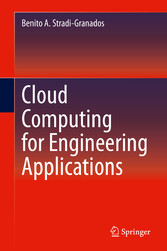Suchen und Finden
Service

Cloud Computing for Engineering Applications
Benito A. Stradi-Granados
Verlag Springer-Verlag, 2020
ISBN 9783030404451 , 384 Seiten
Format PDF, OL
Kopierschutz Wasserzeichen
Geräte
Acknowledgements
5
Introduction
6
Contents
14
List of Figures
17
List of Tables
31
Chapter 1: From the Office to the Cloud, Why Should You Care?
32
1.1 What Is the Cloud?
32
1.2 Cloud Facilities
33
1.3 Cloud Computing
34
1.4 Role of Higher Management
35
1.5 Experience Developing Services
35
1.6 Cloud Services: IaaS, PaaS, SaaS, BPaaS
35
1.7 Starting Cloud Computing
36
1.8 Azure Global Distribution
42
1.9 Current Successes
43
1.10 Extract of Azure Virtual Machines
44
1.11 Use of Microsoft Azure Computational Capabilities in the Doctoral Curriculum
47
1.12 Commissioning a Virtual Machine in Microsoft Azure (Azure VM)
47
1.13 Configuration Summary
55
1.14 Accessing Your Virtual Machine
56
1.15 Configuring Your Virtual Machine
59
1.16 Purchasing Rather Than Provisioning in Microsoft Windows Azure
59
1.17 Virtual Machine Dynamic IP Address
61
1.18 Security and Initial Settings
61
1.19 Computer Configuration for COMSOL Multiphysics©
68
1.20 Installation of COMSOL Multiphysics® 5.4
78
1.21 COMSOL Example: Computer Fan Modeling
85
Further Readings
87
Chapter 2: Generating a Model
88
2.1 Building a Model in COMSOL Multiphysics©
88
2.2 Defining the Physics Involved
89
2.3 Defining the Study
91
2.4 Building the Geometry
92
2.5 Selecting the Materials
96
2.6 CPU Consumption in the Cloud
109
2.7 Boundary Layers
112
2.8 Advanced Features: Batch Processing
114
2.9 Advanced Processing: Parametric Sweep
117
2.10 Case of the Turbulent Flow Fan: A More Elaborate Problem
129
Important Equations: Laminar Flow (spf)
145
Appendix
145
Equation 1. Navier–Stokes Equation
145
Equation 2. Continuity Equation
146
Inlet
146
Equation 3. Inlet Velocity Equation
146
Outlet
146
Equation 4. Pressure Equation
146
Important Equations: Heat Transfer in Solids (ht)
146
Equation 5. Heat Transfer in Solids Equation
146
Equation 6. Thermal Insulation Equation
146
Equation 7. Heat Transfer in Fluids
146
Further Readings
147
Chapter 3: Building a Prototype
148
3.1 The Solidworks Environment
148
3.2 Adding Elements to the Solid Frame
233
3.3 Creating Propeller for Fan
240
3.4 Creating Cylindrical Bushing for Fan Propeller
269
3.5 Assembly
272
Chapter 4: Motion Studies
300
4.1 Building a Motion Study
300
4.2 Flow Simulations
305
Further Readings
329
Chapter 5: Matlab Primer
330
5.1 Basic Annotation
330
5.2 Examples
330
5.3 Arithmetic Operators
331
5.4 Logical Operators
331
5.5 Naming Variables, Programs, and Subroutines
332
5.6 Loops
333
5.7 Matlab Number Format
333
5.8 Reading and Writing
334
5.9 Array Variables
335
5.10 Getting into Matlab
336
5.11 Variable Names
336
5.11.1 Matlab Uses
337
5.12 Exercise 1: Taylor Series
337
5.13 Exercise 2: Newton–Raphson Method
339
5.14 Exercise 3: Gauss Elimination
341
5.15 Exercise 4: LU Decomposition
341
5.16 Exercise 5: Trajectories and Tracking
342
5.17 Exercise 6: Trajectories and Tracking
345
5.18 Exercise 7: Parallel Processing
347
5.18.1 Determine the Processing Time for the Traditional for Loop.
348
5.18.2 Determine the Processing Time for the Parallel Processing parfor Loop.
348
5.18.3 How Many Workers Perform the Parallel Process?
348
Further Readings
357
Chapter 6: Shell Installation
358
6.1 Linux Systems
358
Further Readings
371
Notes
372
Solidworks
373
COMSOL Multiphysics©
374
Matlab
375
Operating System Windows
376
Operating System Linux
377
Index
378
Shop


